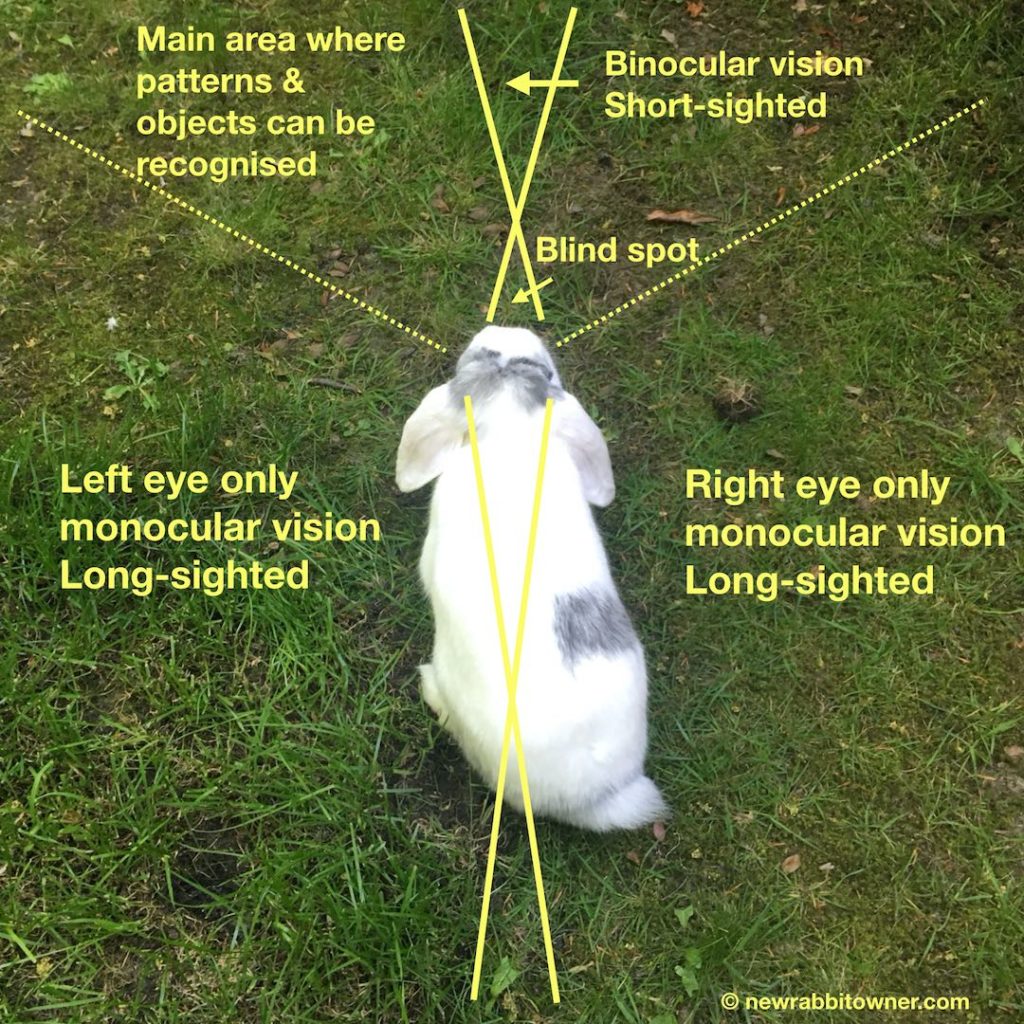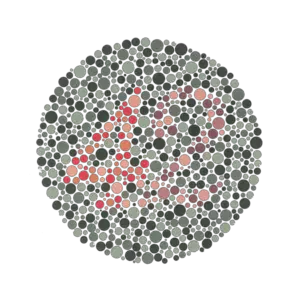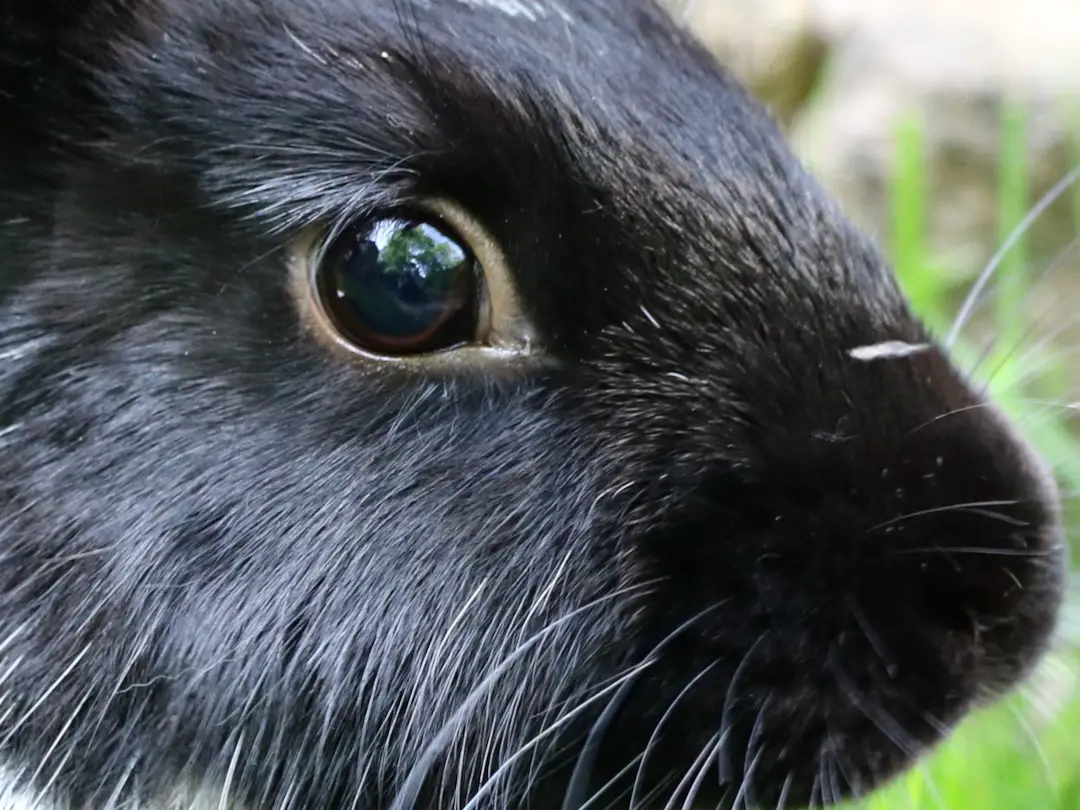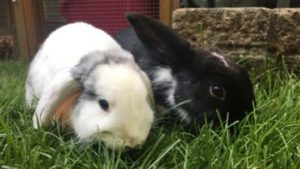Have you ever wondered why your pet rabbit can spot a movement to its side hundreds of feet away, but can’t find the treat you placed right in front of her? Or thought whether or not rabbits see colour the way we do?
I was curious. Fish and Chips, our pet bunnies, sometimes seem to see us from far away, and yet other times seem to have quite poor sight. So I decided to dig around a little, checked out some scientific articles, and discovered more about how rabbits see. This is what I learned along the way about rabbit vision. Here’s a quick summary, with more detail below.
How rabbits see
Rabbits can see all around them at once. Most of their vision is long-sighted (seeing better at far distances), except in front where they become short-sighted. They also have a blind spot directly in front of their nose. Most of their vision is monocular (only using one eye) but rabbits do have binocular vision straight ahead. They recognise patterns and objects best to the front of them. They see colour, but are red-green colour blind. Rabbits’ vision isn’t as sharp as human vision, but they can see better in poor light. Their vision is adapted to see predators quickly from any angle, and to be out feeding at dawn and dusk.
How wide can rabbits see – what is their field of vision?
Rabbits can see just about all around them – they have pretty close to 360o vision.
They achieve this by having their eyes on the sides of their head.
Humans are different. Our eyes are close together at the front of our heads. This helps us hunt for stuff, and we have sharp eyesight. Our priority historically has been hunting – either fruit, or animals.
We’re similar in this to other predators, like cats and dogs and owls.
But rabbits aren’t predators – they’re prey.
The rabbit’s main concern is making sure that nothing is about to eat them. The rabbit needs to see an attacker coming from any direction, so having eyes on the side enable them to see a wraparound view of the world, and keep them safer.
There is a downside to this. First of all, it means rabbits have a blind spot right in front of their noses, where they have no vision.
This is why you can place a treat directly in front of your bunny, and she’ll not respond. She’s not being picky (this time…) – she just hasn’t seen it yet.
Secondly, while rabbits can see all around them, they don’t have binocular vision for most of this.
Binocular vision is how we see the world – our brain can integrate the information from our two eyes and create a 3-D picture of what’s in front of us. Rabbits only have a small part of their sight where they can do this – mostly they rely on one eye. To get a little idea of what the world looks like for a rabbit, just close one of your eyes.
Do rabbits see equally well all around?
If rabbits can see all around them, is their vision equal throughout? The answer is no, in a number of different ways.
Rabbits look ahead to see patterns and recognise shapes
First, rabbits see patterns better using the parts of the eye facing frontwards – an angle of about 60o either way (have a look at the diagram). So if a rabbit wants to make sense of what he is looking at, he’ll look towards something. The rear part of their vision is mainly there to warn of any movement – this could be a predator creeping up on them.
We know this from experiments done by de Graauw & van Hof (1980), who covered up different parts of rabbits’ eyes & saw whether or not they could recognise patterns (tested by rewarding the rabbits with food if they could). If the rabbits had to rely on the rear 120o of vision, they did no better than chance. Abstract here.
Rabbits are both long-sighted and short-sighted
Rabbits are generally long-sighted (hyperopic is the technical term). This means that they can see objects more clearly if they are further away, and less clearly if they are too near.
This makes sense – the bunny’s main concern is looking out for attacks coming from the distance.
This is true both round the rabbit’s vision horizontally and vertically.
However, when you get to the front of the rabbit, things change. As you move to in front of the rabbit’s face, the rabbit’s vision becomes short-sighted (myopic).
Right in front of the rabbit (but beyond their blind spot) their vision is about -5 dioptres – I’m pretty short-sighted myself (I need glasses all the time) and this is about the same as me.
This means that rabbits can see close up the things in front of them (like food or toys).
To sum up – most of their vision is adapted to be sensitive to possible threats in the distance, but part of their vision is perfect for checking out stuff close by.
The research papers that discovered these aspects of your bunny’s vision are de Graauw & van Hof (1978 & 1980). You can get the abstracts here and here.

Do rabbits use binocular vision?
As explained above, most of the rabbit’s field of view is coming from one of their eyes. They don’t overlap much except a little at the front.
This got researchers wondering whether rabbits bother at all using binocular vision (where the brain integrates the signals from both eyes together).
What they have found is that, most of the rabbit’s vision is monocular, and the rabbit is fine with that. It is quite capable of processing both eyes independently.
However, they can also use both eyes together in the narrow overlap in front of them. So if your rabbit is looking straight ahead, it might be seeing the world in 3D similar to us.
The research discovering this was done using different coloured filters over each eye and requiring both eyes to work together for patterns to be visible. The work was done by van Hof & Russell (1977) – you can find the abstract here.
Do rabbits have good eye sight?
Rabbits don’t have as sharp eyesight as humans. We can distinguish lines that are 1/60th of a degree apart (lines closer than this blur together for us).
Rabbits don’t do as well – they can only distinguish lines about 1/3-1/6 of a degree apart.
This is slightly worse than cats (1/12th of a degree) but better than rats (about 1 degree).
Check out van Hof (1967) for more information – abstract here.
What does this look like? If you’re about 50cm or 18” away from this screen, then you can probably tell lines that are 0.15mm or 0.005” apart. In contrast, your rabbit will struggle with lines 1.5mm (0.05”) apart.
So rabbits don’t have as sharp eyesight as humans – but their eyesight is ideal for their purposes. The next section explains a bit more why.
Can rabbits see colour? Are rabbits colour blind?
Rabbits can see colour, but by human standards they are slightly colour-blind. Bunnies can see colour a little like some humans who have a particular type of red-green colour-blindness.
Eyes have two different types of cells that react to light (photoreceptors) and pass on signals to the brain. These are called rods and cones.
Types of photoreceptors
Rods are sensitive to blue-green light (peak wavelength 498 nm). These are used in poor light conditions. It is the rods in your eyes that are working when your eyes are trying to adjust to the dark.
Cones are more sensitive, and give us our colour vision. They come in three varieties in humans:
- Red (or L-cones, most sensitive to red light at 564nm);
- Green (or M-cones, most sensitive to green light at 533nm);
- Blue (or S-cones, most sensitive to blue light at 437nm).
(The L, M and S stand for Long wave, medium wave, and short wave, and refer to the wavelength of the light – you can find out more here).
Rods and cones in rabbits – types
Rabbits also have cone photoreceptors – but only the green and blue cones (at slightly different peaks – 520nm and 425nm).

This means that, compared to most humans, they are slightly colour-blind (protanopic or dichromatic). Some humans (about 1% of males) also have only functional green and blue cones – this is a form of red-green colour-blindness.
So rabbits do see colours, but will find it hard telling reds and greens apart, and also blues and greens.
But there’s another difference between rabbits and humans.
Rods and cones in rabbits – where they are in the eye
The distribution of rods and cones is different between bunnies and us.
In humans, most of our retina (the back of the eye) is made up of rods. But there’s a small central indented area (the fovea centralis – more here) that is packed with cones (180,000 per mm2). This means that when we look at something directly, it is our cones that are picking up the visual information.
This is also why, when it’s dark, you see better to the side of whatever you’re looking at directly. Your peripheral vision is using rods, which work well in dim light (but don’t give much colour information), while your central vision is using cones which need brighter light.
But rabbits don’t have their cones concentrated in the centre, but in a horizontal streak across the retina (this is called the visual streak). Most of these are green cones (up to 13,000 per mm2) with some blue cones (up to 2,500 per mm2).
In the lowest part of the retina, there is a blue streak – a crescent shape that has no green cones, but only blue cones (up to 11,000 per mm2).
How do the cones help rabbits?
What does this mean in practice? Having a wide horizontal band of cones enables rabbits to see more clearly all around them. Rather than having to look directly at something to see sharply (as humans do), rabbits have sharper vision all around them.
This is another way that rabbits’ vision is adapted to help them survive. They are able to spot and identify attackers more easily because they have this wide band of cones.
But what is the blue streak about? This is located at the bottom of the retina, which means that it is the light from above that reaches it. Researchers have suggested that this gives great sensitivity to spotting any attacks coming out of the predominantly blue sky.
In other words, the blue streak helps the rabbit to monitor the sky for threats, and the visual streak (mostly green cones) helps the rabbit to keep watch on the ground and horizon.
So rabbits do have good vision – good for spotting predators.
You can read more about the visual streak and blue streak in the research by Juliusson et al (1994). You can see the abstract here.
Can rabbits see in the dark?
Rabbits can see in the dark better than humans, but not in pitch black. Bunnies have eyes that are adapted to work best at dusk and dawn, but rabbits are not nocturnal animals. Their night vision is better than humans, but poorer than some other mammals.
Some nocturnal animals (including cats) have a mirror-like backing to the retina that helps the eye detect every ray of light (this is called the tapetum lucidum). Rabbits don’t have this (neither do humans). Rabbits can see about twice as well as humans in poor light.
Rabbits have both rod and cone photoreceptors. The rod photoreceptors help them to see in poor light conditions. A rod photoreceptor can detect a single photon of light.
Rabbits have far more rods than cones (up to 300,000 per mm2 – see Famiglietti & Sharpe (1995) – abstract here).
The peak concentration of rods is about twice that of humans – so rabbits can see better in the dark and in low light conditions than humans. However, they are not fully adapted to see at night.
Rabbits have adapted to see best at dawn and dusk (rabbits are crepuscular – see our article on when rabbits are awake and asleep, and also on whether rabbits are nocturnal). In these conditions, their combination of lots of rods and blue and green cones enable them to spot any potential threats, whether from land or sky.
The rods make sure that they are sensitive in poor light conditions. The blue and green cones make sure that they have colour contrast ideal for dawn and dusk. How come?
When the sun is low in the sky, the direct light is particularly yellow, while reflected light is particularly blue. The rabbit’s green and blue cones are ideally placed to detect any objects lit with these contrasting colours. See Nuboer and Moed (1983) for more information (abstract here).
So rabbits can’t see in pitch black, and are not nocturnal animals. But their eyesight is ideal for an animal that comes out at dawn and dusk in poor light, wary of any predators that are looking to pounce.
Can rabbits see infrared?
Rabbits cannot see infrared. They have poorer vision for red light than humans, as they don’t have any red cones in their eyes. Infrared light is beyond what is visible to them.
Do rabbits blink their eyes?
Rabbits do blink, but much less often than humans. They blink about once every five minutes.
They need to blink far less because they have an extra (transparent) eyelid – called a nictitating eyelid or membrane. This helps keep their eyes moist whilst enabling them to continue keeping an eye out for predators.
Rabbit eye problems
If you are concerned about your bunny’s eyes, check in with a vet, and also have a look at our page on common symptoms and what you can do at home to help.
More articles…
If you liked this article, read our article on how and when rabbits sleep.
You can also find out more about how rabbits hear, and how fast bunnies run.
Just want to treat your bunny? Check out our in-depth articles on what herbs are safe for rabbits, and what fruit are safe for rabbits.
And have a look at our suggested toys (all tested by our own rabbits).


